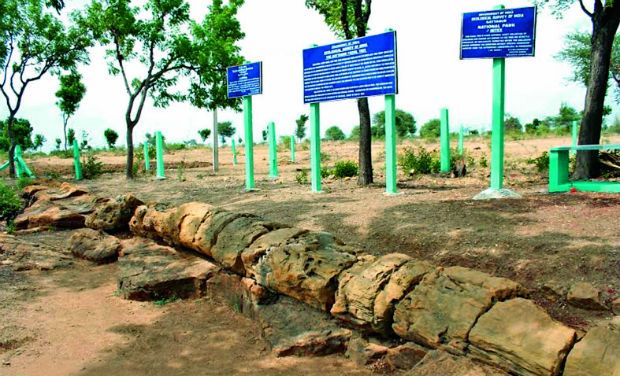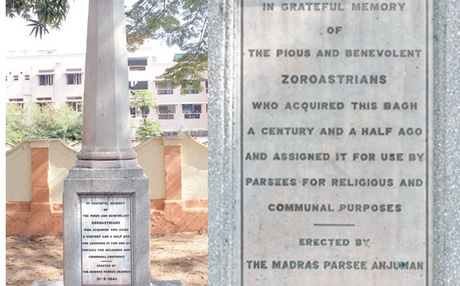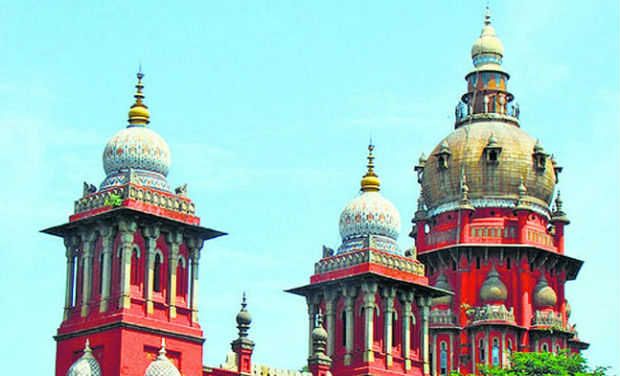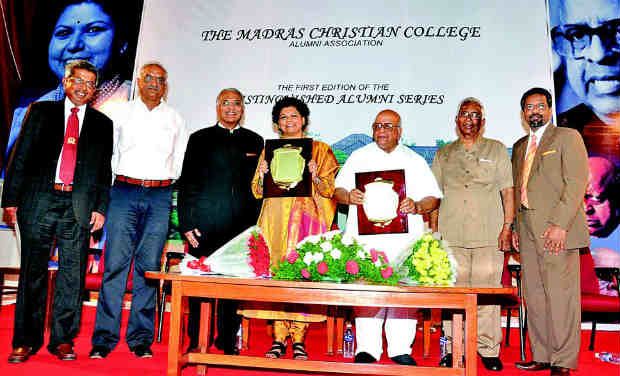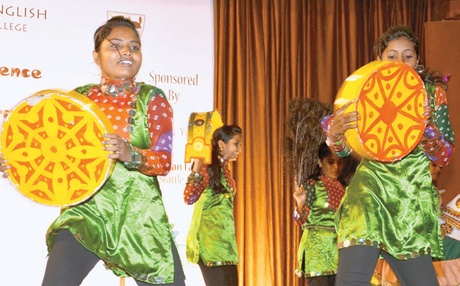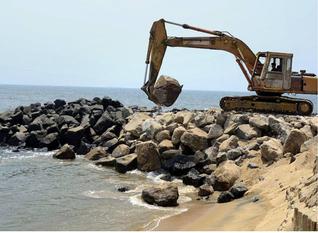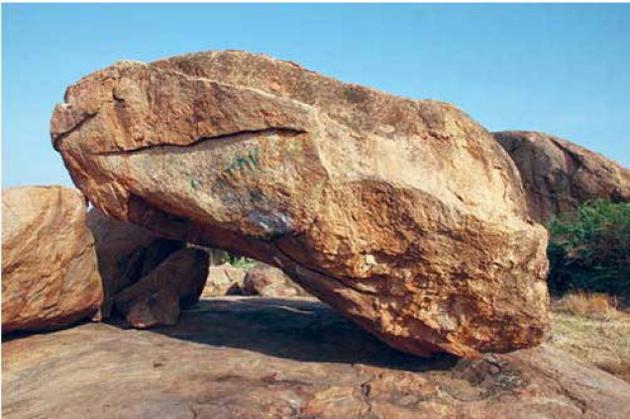
The cave with early Tamil-Brahmi inscription in Samanarmalai. / The Hindu
Following the discovery of the Tamil-Brahmi cave inscription at Samanarmalai near Madurai (The Hindu, March 24, 2012), the photographic survey team of the Central Institute for Classical Tamil (CICT), Chennai, visited the site in May. It secured high-resolution photographs and HD videos, which were computer analysed. In the first part of this article, M.V. Bhaskar, co-ordinator, CICT Project, reports on the survey of the site. In the second, Iravatham Mahadevan proposes a revised reading and interpretation of the inscription based on the CICT survey.
The Jaina monuments
The recent discovery of a Tamil-Brahmi inscription in a cave (Fig.1) at Samanarmalai near Madurai is of exceptional importance due to its location and early date. It is the 95th Tamil-Brahmi stone inscription digitised as part of the CICT Photographic Survey (2007-12), the aim of which is to build, for posterity, a comprehensive archive, on HD video and high resolution still imagery, of these priceless records of civilisational heritage, and to disseminate their content and context in all the forms that traditional and modern media allow.
The survey covers, apart from the inscriptions, records of each of the sites as they were before Tamil-Brahmi, as cradles of human habitation from the pre-historic times, and the historical continuity that extended, in most cases, up to the medieval period.
To shift focus back to Samanarmalai (“Hill of the Jainas”), it was closely associated with the famous Jaina monastery known as Tirukkattampalli at Kurandi, a village about six km south of the hill. The monastery flourished during the medieval period from about the 8th to the 12th century C.E., but is no longer extant. It was either destroyed or allowed to fall into ruins. Evidence points to the former. Stone blocks from the ruins, inscribed with the name of Tirukkattampalli Jaina monastery, are now found built into a Siva temple at Sivamadam, a nearby village.
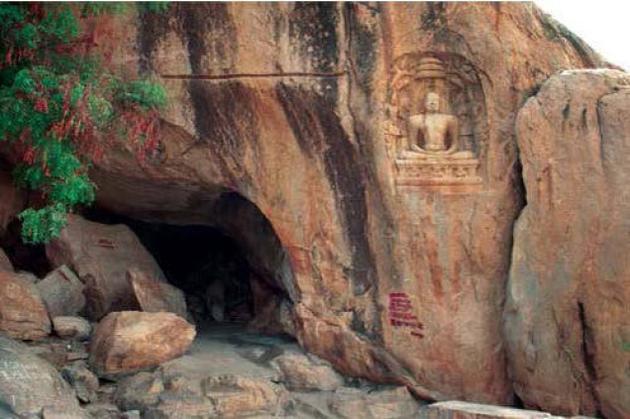
Settipodavu: Another Jaina site on Samanarmalai with sculptures of Tirthankaras and Vatteluttu inscriptions (9th century C.E.). /The Hindu
Geographically, Samanarmalai is an extensive complex of low rocky hills stretching more than three km. Two well-known Jaina monuments are on this hill, Settipodavu (Fig.2) at the base, and Pechipallam (Fig.3), one level above, both with sculptures of Jaina Tirthankaras and Vatteluttu inscriptions of about the 9th century C.E. A further level above Pechipallam and a level below the newly discovered Tamil-Brahmi cave are remains of a Jaina structure up to the basement level. A hillock with Jaina vestiges adjoining Samanarmalai tragically collapsed in the late1990s, due to heavy quarrying nearby.
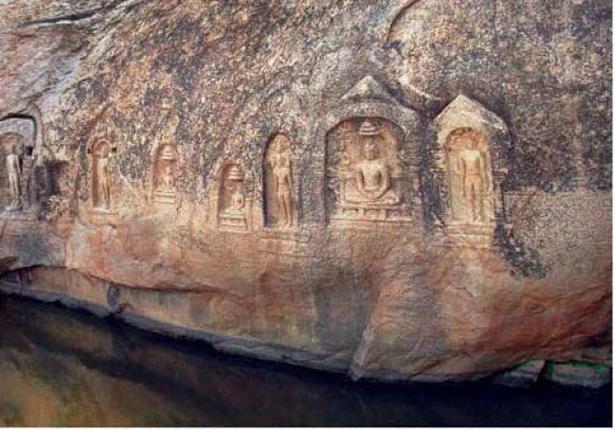
Pechipallam, a natural pool on Samanarmalai hill with sculptures of Jaina Tirthankaras and Vatteluttu inscriptions (9th century C.E.) on the boulder overlooking the pool. / The Hindu
The Samanarmalai complex, in the wider sense, includes the adjacent hills at Muttupatti and Kongarpuliyankulam, which have caves with a large number of stone beds, besides Tamil-Brahmi inscriptions dating from the 2nd century B.C.E. The recent discovery (Fig.4) has pushed back the historicity of Samanarmalai to well over 2,000 years, coeval with the earliest Tamil-Brahmi inscriptions. It appears that the caves with very numerous stone beds in the Samanarmalai region served as places of retreat for the Jaina monks of the Tirukkattampalli monastery during the rainy season (vassa).
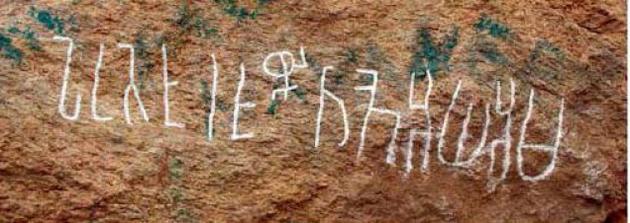
Tamil-Brahmi cave inscription at Samanarmalai. / The Hindu
To reiterate the importance of Samanarmalai, several inscriptions form Jaina temples across Tamil Nadu and South Kerala refer to the Tirukkattampalli monastery and its illustrious line of Jaina teachers including Ajjanandi. The inscriptional evidence indicates that Tirukkattampalli-Samanarmalai was the central seat of authority for Jainism in the Tamil country, even as Sravanabelagola still is for the Jainas of Karnataka. Inscriptions (12th century C.E.) on the basement of the ruined Jaina temple above Pechipallam refer to visits of senior Jaina monks from Sravanabelagola, some of whom chose to end their lives through sallekhana (fast unto death) on the Samanarmalai hill. Here is clear evidence that the fame of Samanarmalai had spread beyond the borders of the ancient Tamil country.
The Tamil-Brahmi inscription
The newly discovered Tamil-Brahmi inscription at Samanarmalai may be assigned to about the 2nd century B.C.E. on palaeographic evidence. The tall and narrow characters and the archaic orthography, indicate that the inscription belongs to the earliest period like those at Mangulam, also near Madurai.
The brief one-line inscription reads:
peruterur uzhi taatai ay-am
(pool (of) Taatai at Peruterur)
The inscription commemorates the association of a person known as Taatai with the pool on the hill, which was probably deepened or renovated by him. Some interesting aspects of the four words comprising the inscription are noticed below.
Peruterur appears to be the earlier name of the village now known as Kilkuyilkudi at the foot of the hill. The earlier name suggests that it was a large village with streets wide enough for chariots to pass through. The word ter occurs here in the old sense of “(horse-drawn) chariot” and not with the later meaning of “(temple) chariot” as there were no structural temples at that time.
Uzhi is an archaic grammatical term for the locative (seventh) case-ending “in, at” (Nannul 302), as inpunattuzhi “in the field (of dry crops)” (Akananuru 388:13).
Taatai literally means “father” and occurs in this sense in the Sangam poems (Paripaatal). This is one of the kinship terms borrowed by Indo-Aryan from Dravidian. The word taata is used in Prakrit also as a respectful or affectionate form of address towards an elder person. The word taatai seems to occur in the latter sense here.
Ayam (spelt ay-am) means a “pool or mountain spring”. The deep natural pool at Pechipallam (Fig.2) found near the cave seems to be the one mentioned in the inscription. It is significant that this pool is presently known as Pechipallam, as pallam “hollow or pit” is a synonym for ayam (Tamil Lexicon), andPechi (from Peychi) is perhaps a reference to the yakshis found among the Jaina sculptures.
Apart from the general problems in deciphering 2,000-year-old, weathered and vandalised inscriptions engraved on rough, unhewn and undulating rock, this particular inscription poses additional challenges. The 4th and 6th letters look identical but must be read differently to suit the context. The 3rd, 8th and 9th letters look different but must be read alike, as t. The use of the long vowel u (6th letter) for the short vowel, and writing ayam as ay-am, splitting the suffix, are characteristic orthographic peculiarities found in the earliest Tamil-Brahmi inscriptions in this region (Early Tamil Epigraphy 2003).
A combined assault by the technical team, epigraphists and linguists has succeeded in deciphering the inscription, which confirms that the largest Jaina establishment of Tamil Nadu is also the oldest.
For further reading: R. Champakalakshmi 1975. Kurandi Tirukkattampalli: An ancient Jaina monastery of Tamil Nadu. Studies in Indian Epigraphy vol. 2: pp. 84-90. This is the definitive paper on the subject. We have drawn liberally from this source.
In situ tracing: K.T. Gandhirajan
Photographers: A. Sarangarajan and K. Thanigaimani
source: http://www.TheHindu.com / Home> Arts> Magazine / by M.V. Bhaskar & Iravatham Mahadevan / January 05th, 2013
